
07 Aug ‘Future-proofing’ green hydrogen investments
John Grobler takes an inside look at a green hydrogen project that has made the most visible progress of nine such projects currently under development in Namibia

New track: Cleanergy is also in a joint venture to convert a TransNamib locomotive to using hydrogen instead of diesel. Photo: John Grobler
As strategic locations go to showcase cutting-edge green technology to an emerging market, Cleanergy’s state-of-the-art green hydrogen plant on Farm 58 outside Walvis Bay could not get any better.
Not only is this where the roads connecting Namibia’s three (planned) northern and southern Green Hydrogen Corridors intersect, but it is also where hundreds of foreign-registered fuel-tanker trucks pass by every day on their way on or out of the port.
On a recent foggy Friday morning, the majority of those trucks driving past the Cleanergy site were foreign-registered, transporting fuel supplies to the mining industries of the neighbouring landlocked Democratic Republic of the Congo, Zambia and Botswana.
So how many of those fuel-tankers must be willing to turn off the highway and fill up at Cleanergy’s two gleaming new hydrogen pumps before the US$30-million investment in a state-of-the-art hydrogen plant and training centre turns a profit?
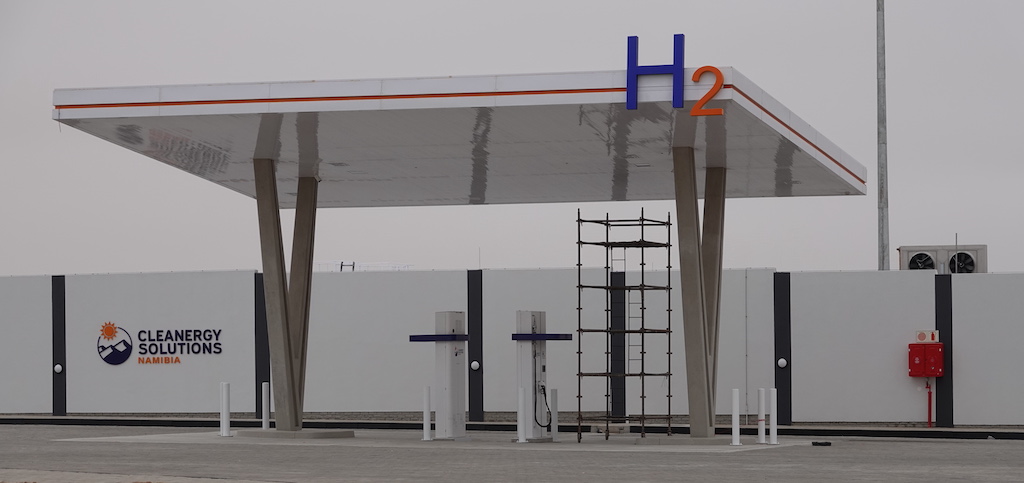
Filling station: Cleanergy’s two gleaming new hydrogen pumps. Photo: John Grobler
New technology
“The first step is to introduce and gain experience in a completely new technology, which always takes a long time,” especially if it’s necessary to up-skill the local labour pool to make it sustainable, said Sathish Ravi, Cleanergy’s chief site engineer.
Since the late Namibian President Hage Geingob announced his ambitious green hydrogen economy initiative in June 2021, Cleanergy – a Belgian-Namibian joint venture between CMB.TECH and Ohlthaver & List – has made the most visible albeit limited progress of nine green hydrogen projects currently under development, according to independent energy consultant Detlof von Oetzen.
Cleanergy’s 5MW PV solar plant is already installed and can under optimum conditions produce 600kg of green hydrogen a day, or up to 900kg if the solar plant is expanded to enable the electrolyser to run at its maximum design capacity, Ravi explained.
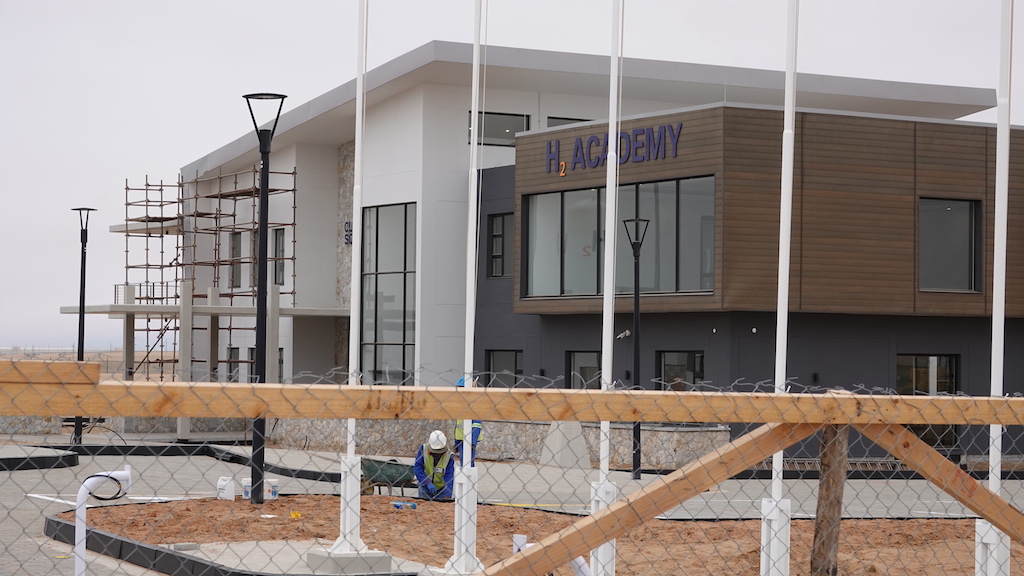
Training centre: Most trainees are expected to come from the Namibia Institute for Mining Technology. Photo: John Grobler
Technological marvel
The Farm 58 plant is a technological marvel of stainless steel and imported high tech, built to the highest European standards with each electrical component earthed to a grid buried underneath the plant.
As for water, the plant will use about 15 cubic metres a day supplied by the municipality – about the same amount used by the local fishing factories. This works out to 25 litres of water for every kilogramme of hydrogen produced, the bulk of which is used for cooling and maintaining the plant.
Although it is not a high amount of water for a plant of this kind, it is a concern in a water-scarce country and municipality. With that in mind, the plant is designed to recycle every drop not used in the electrolysis process to water the gardens the company is establishing around the futuristic new training centre that is expected to open its doors in early 2025.
Most trainees are expected to come from the Namibia Institute for Mining Technology (NIMT), based in Arandis in the Erongo region, to be trained in modifying diesel trucks to hybrid diesel-hydrogen units, among other skills.
This involves modifying the intake manifold and fitting a stack of hydrogen tanks that require extending the truck chassis, a process that adds about 30% to the sticker price of a new truck – but will also reduce diesel consumption and related emissions by 30%.
Ravi said that, upon completion, Farm 58 would be the most modern of its kind in the world. He previously worked at CMB-TECH’s Antwerp-based plant, which has been developing hydrogen and ammonia-fuelled hybrid ship engines for the shipping giant’s 146-strong fleet.
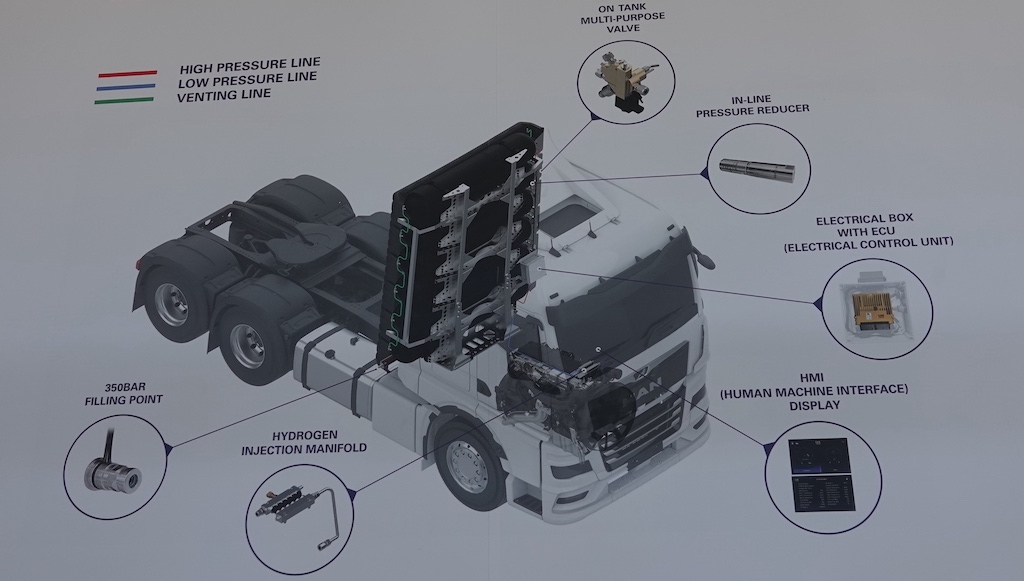
Dual-fuel model: A CMB.TECH diagram showing how a stack of six hydrogen tanks is fitted to a standard truck. Graphic supplied
Carbon emissions
It is unclear whether the project will contribute to reducing carbon emissions. Many of the passing trucks are older, worn-out, smoke-belching models exported on the cheap from Europe to Africa.
Eike Krafft, group manager: innovations for the Ohlthaver & List Group and Cleanergy development committee member, said that by fitting a stack of six hydrogen tanks and some relatively small modifications to a standard truck’s intake manifold and engine management system, they could take some of the worst polluters off the roads.
As 1kg of hydrogen is energy equivalent to 3.4l of diesel, Cleanergy’s daily output of 600kg of hydrogen fuel would be enough to refuel 27 dual fuel trucks, Krafft explained. “Once the current output capacity is reached, the current hydrogen production can be increased by increasing the solar farm or by installing more electrolyser capacity. The technology [is] modularised, so the production capacity can be easily matched with the increasing offtake,” he added.
There are questions about whether the use of green hydrogen and ammonia as fuel is economically viable beyond a few niche uses. Because it requires 55 kilowatt-hours of electricity to produce 33 kilowatt-hours’ worth of hydrogen fuel at an estimated cost of US$5-9 per kilogramme, many argue it would be more sensible to electrify heavy vehicles directly instead.
International clean energy guru Michael Leibbrich maintains that for this reason, the use of hydrogen for long-distance freight is limited to a “small market share” of specialised, short-haul trucks used in urban environments. Given the cost and scarcity of hydrogen fuel, the hundreds of cross-border long-haul trucks trundling past Farm 58 every day seem an unlikely target market.
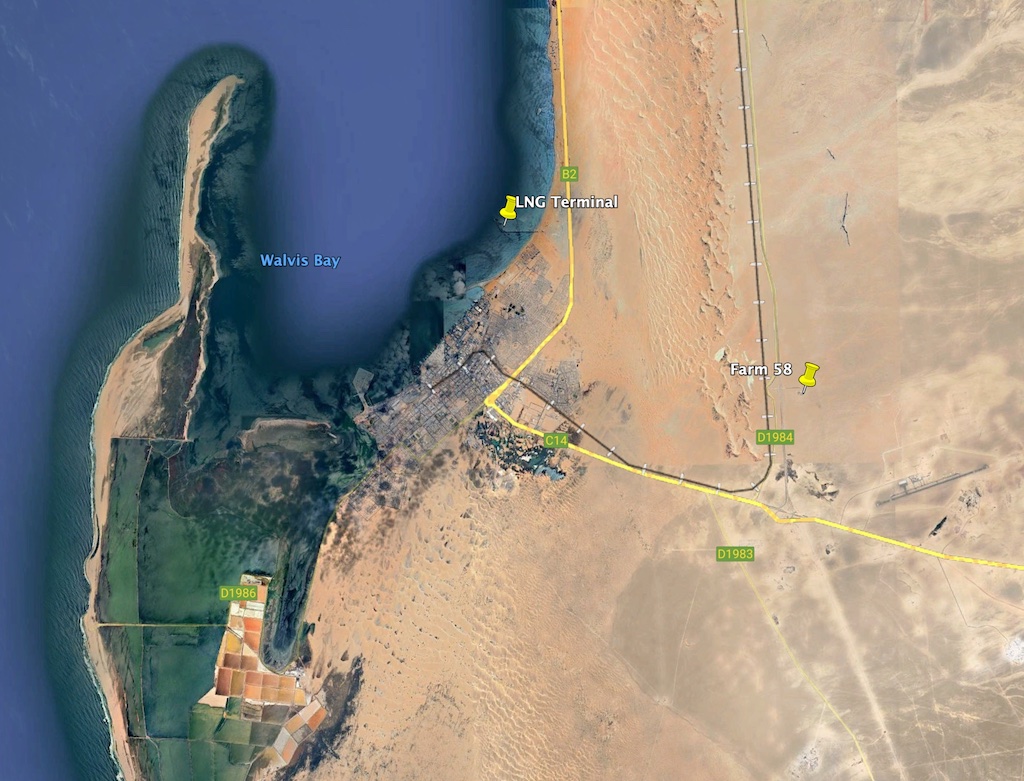
Farm 58 is phase one of a three-phase project that leads to a new industrial zone known as North Port on Walvis Bay’s northern outskirts. Graphic supplied
‘Future-proofing’
CMB.TECH’s local representative, Liesbeth Verhaert, responded that trucking is just the most visible component of “future-proofing” the Belgian shipping giant’s global operations along every step of the logistical chain. Their primary focus is on developing and testing maritime applications like ammonia-fuelled ship engines for their fleet of new low-carbon vessels currently under construction, she said.
“This is just phase one, the primary goal of which is to conduct research and development on materials like types of steel” and various high-pressure vessels imported from specialist manufacturers, she said. CMB.Tech also planned to test various other applications for powering forklifts, tugboats and other harbour craft as part of their quest to de-carbonise their global operations.
The second phase is to procure land from the Arandis Town Council to construct a one gigawatt solar farm and hydrogen plant to produce 185,000 tonnes of ammonia a year. The hydrogen produced in Arandis will be pumped via a 80-km-long, high-pressure carbon-steel pipeline to the Farm 58-based plant at the coast, Verhaert said.
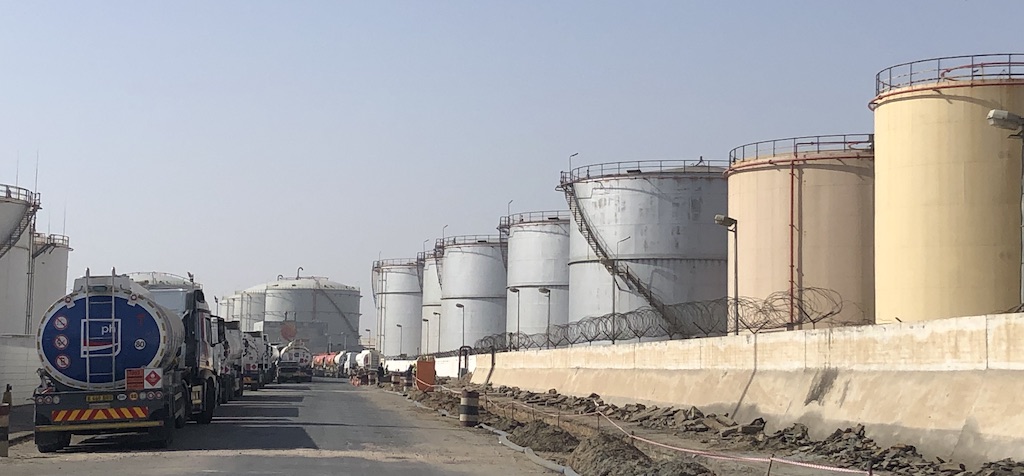
Passing trade: Just a few dozen of the hundreds of fuel tankers at the Walvis Bay tank farm moving diesel and petrol to neighbouring Zambia and Botswana every day. Photo: John Grobler
North Port
Here, the hydrogen will be converted to ammonia and pumped 10km to what will be phase three of the project – a 40,000 ton ammonia storage and distribution facility to be constructed in a new industrial zone known as North Port on Walvis Bay’s northern outskirts.
The central feature of North Port is the new National Petroleum Corporation of Namibia’s fuel and gas terminal, designed to accommodate floating storage regasification units to supply the gigantic ships designed to carry liquid natural gas (LNG) in refrigerated tanks.
North Port is central to Namibia’s plans for energy self-sufficiency. Together, North Port and Farm 58 form the core of the official Harambee II development plan to develop Walvis Bay into a regional energy and mineral beneficiation export hub, to be known as the Walvis Bay Gasport.
On the beach along the outskirts of the still-empty North Port industrial zone area, a billboard erected by Namport and the Port of Antwerp Bruges in February during a state visit by Belgium’s King Phillippe proclaims Walvis Bay as “the gateway for Namibia’s green industrialisation process”.
Although phase three is still a few years away, Cleanergy has already reserved space for its ammonia storage and distribution plant at North Port, Krafft confirmed.
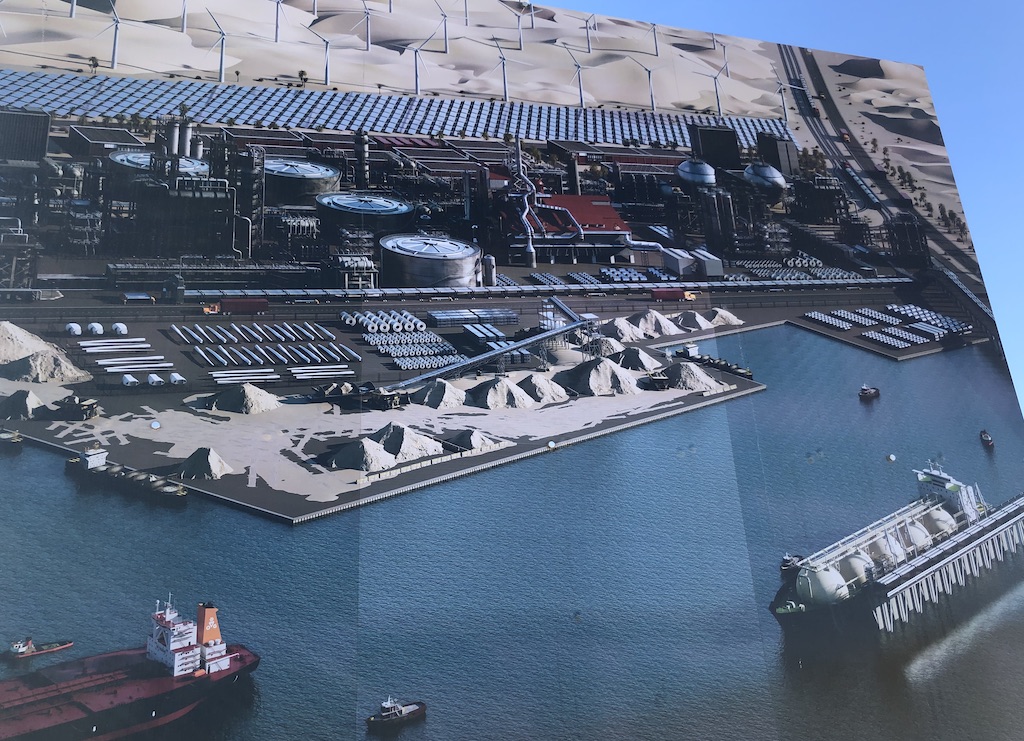
‘Gateway for Namibia’s green industrialisation process’: North Port and Farm 58 form the core of the official plan to develop Walvis Bay into a regional energy and mineral beneficiation export hub. Graphic supplied
Oil refinery
At the local municipal planning office, an environmental impact assessment notice posted on behalf of Ikhaya Somandla Family Trading Enterprises (ISF Trading) shows plans for a 300,000 barrels-per-day oil refinery, a 500MW renewable energy plant, battery energy storage facilities, storage tanks and related offices and warehouses on Portion 46 of the Farm 58 industrial zone.
According to the submitted EIA documentation, ISF Trading plans to take up the largest section of Farm 58, and claims to have major financial backing from investors in Dubai and Brazil – including a US$58-billion line of credit from the Central Bank of Brazil – for the US$83-million project.
ISF states it will create more than 12,000 jobs during construction and nearly 3,500 permanent jobs, including 80 civil, electrical and chemical engineers – in a country that has a shortage of engineers.
Another green hydrogen project, Chiffon Green Hydrogen, as well as a company called Erochem, are to move in next door to Cleanergy, according to ISF’s submitted ground plans.
Like several other green hydrogen proposals currently being promoted, the scale of these other projects appears to ignore real limitations in terms of local capacities, technical know-how and capital – the two key challenges that research indicates Cleanergy has so far managed to overcome.
Roman Grynberg, a local economist, pointed to a third, more compelling reason why Cleanergy’s project stands a better chance at success than any of the other green hydrogen projects: in CMB.TECH’s fleet of 106 low-carbon and ammonia-burning ships, the company will likely be its own main client for its own ammonia fuel – and the expenses can be off-set against carbon credits one day – thereby, as CMB.TECH puts it, “future-proofing” all its operations in all respects.
John Grobler is a Namibia-based associate at Oxpeckers Investigative Environmental Journalism. This investigation was supported by the Heinrich Böll Foundation, but does not reflect its views
• Find more investigations in our green hydrogen series here
